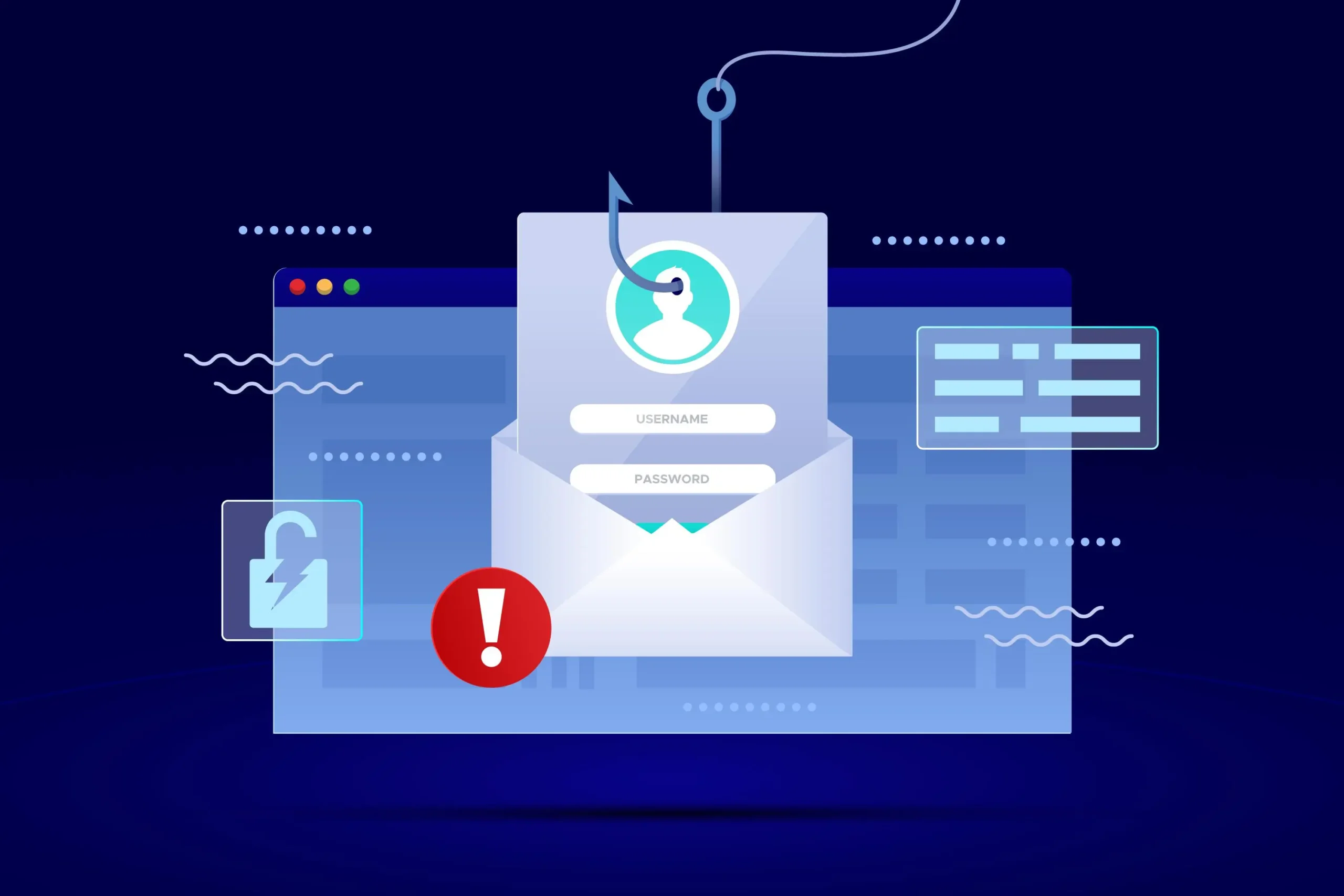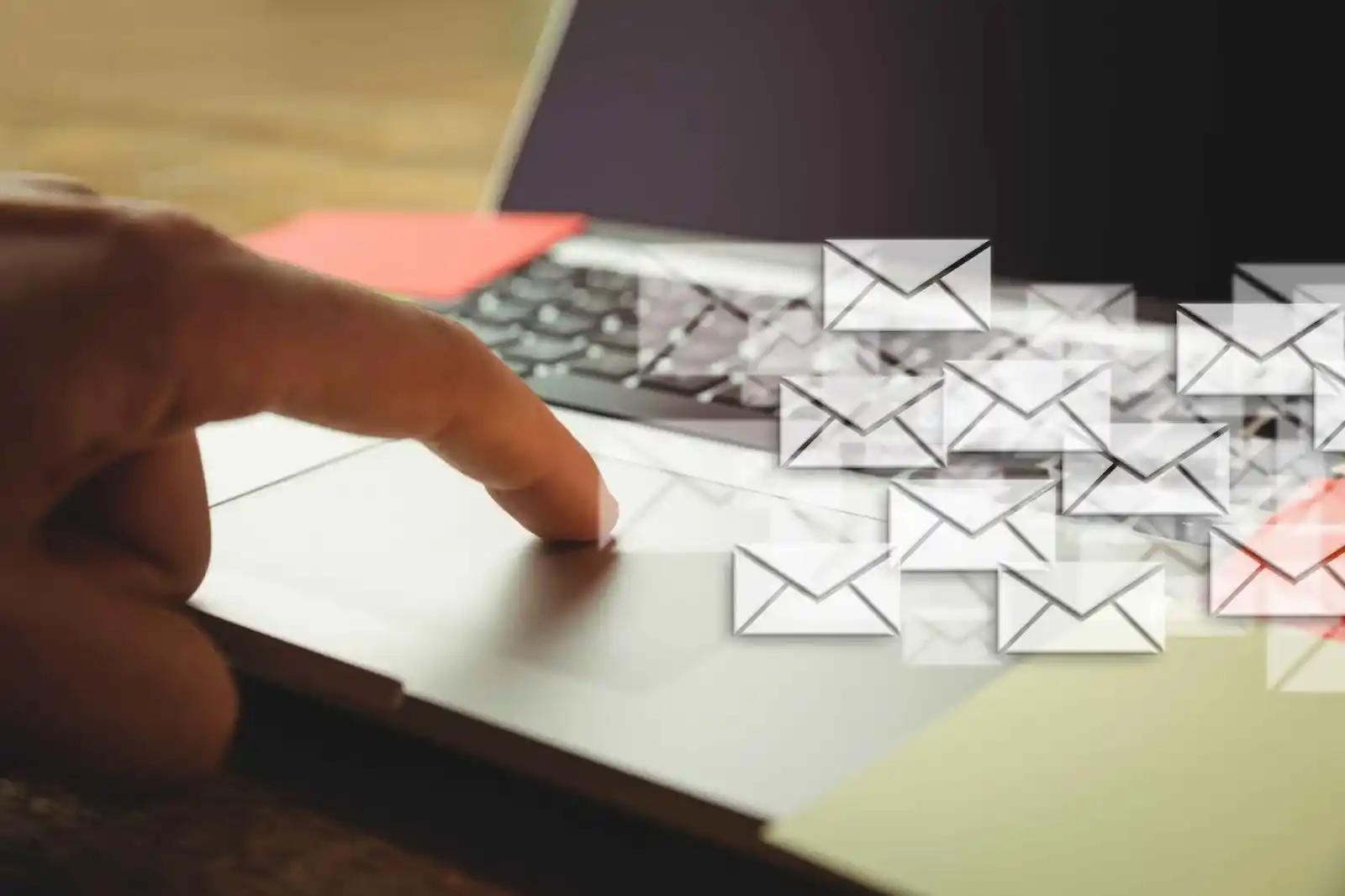Clicking on a phishing link can be a scary and confusing experience. It often happens in a quick second: an email, a text, or a message that looks real enough to trust. In fact, according to Huntress, over 90% of cyberattacks begin with phishing, which shows just how common and dangerous this type of threat really is.
In this post, you’ll learn what happens if you click on a phishing link and what steps you should take immediately to protect your accounts, personal data, and reduce the risks as much as possible.
Need support after a scam? Join our community today.
What Happens If You Click on a Phishing Link?
When you click on a link in a phishing email, the result depends on how the scam was designed. A lot of things can happen depending on how the scam was designed, opening the door to different risks like stolen data and frequent attempts to exploit your trust.
Clicked on a phishing link? Here’s what could happen:
1. Redirect to a Fake Website
The link can send you to a page that looks almost identical to a trusted service. The goal is to make you type in details like usernames, passwords, or payment information. This trick is common in clone phishing, where attackers copy a legitimate message or site to make the scam look more convincing.
2. Silent Malware Download
Some phishing links produce a hidden download of malicious software. This malware can steal saved credentials, monitor your activity, or even give attackers remote access to your device.
3. Validation for Scammers
In some cases, clicking the link is enough for criminals to confirm that your email address or phone number is active. This can result in more phishing attempts, spam, and targeted attacks in the future.
4. Account Takeover
With stolen login details, attackers can break into your email, social media, or banking accounts. Victims often get locked out, while scammers impersonate them to trick others or carry out fraud.
5. Financial Loss and Identity Theft
Stolen details can be used to make unauthorized purchases, drain bank accounts, or even apply for credit in your name. Beyond money, your identity can be misused in ways that are difficult and stressful to undo.
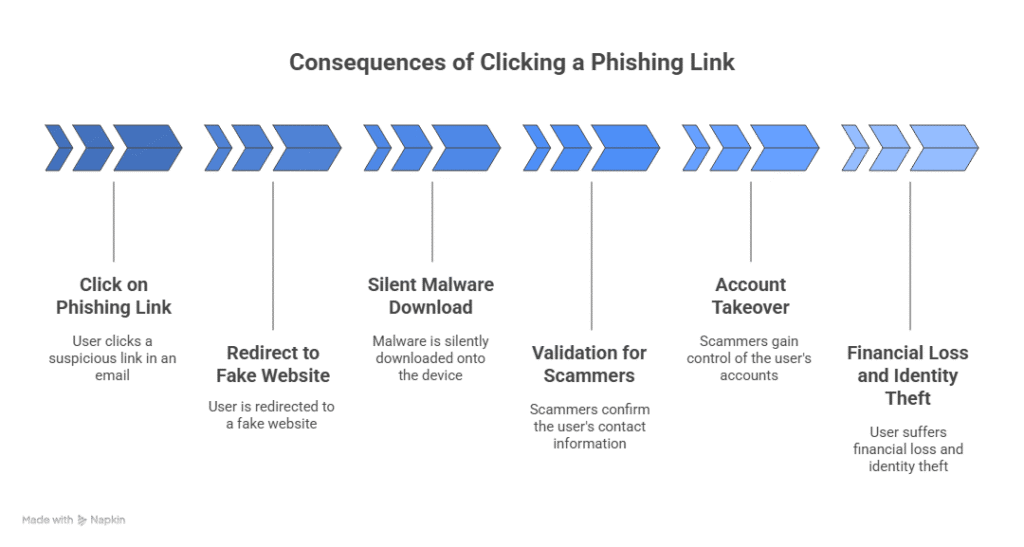
How Do You Know If You Clicked on a Phishing Link?
Not everyone notices right away that they’ve fallen for a phishing attempt. In many cases, the signs appear gradually. Paying attention to these signals can help you check if something is wrong:
- Unexpected downloads or pop-ups right after clicking the link.
- Strange behavior on your device, such as slow performance, apps crashing, or battery draining faster than usual.
- Emails or messages sent without your knowledge, often seen in your outbox or activity log.
- Trouble logging in to accounts because your password was changed without your action.
- Alerts from your bank or online services about transactions or login attempts you didn’t make.
What Should You Do After Clicking a Phishing Link?
If you realize you clicked on a phishing link, here are the first steps you should take immediately:
- Disconnect from the internet: Turn off Wi-Fi or mobile data to stop any ongoing data transfer between your device and the attacker.
- Run a full security scan: Use trusted antivirus or anti-malware software to check phishing on your device. Remove anything suspicious it detects.
- Change your passwords: Update the login details for your most important accounts, especially email, banking, and social media. Choose strong, unique passwords.
- Enable two-factor authentication (2FA): Adding an extra layer of protection makes it harder for criminals to access your accounts, even if they have your password.
- Check your accounts for unusual activity: Look for login attempts, unknown transactions, or messages you didn’t send. Report anything suspicious to the platform immediately.
- Contact your bank or credit card provider: If you entered financial details, let your bank know right away so they can monitor and block fraudulent activity.
- Report the phishing attempt: Forward the suspicious email or message to your email provider, employer, if it happened at work, or directly to cybersecurity organizations that collect phishing reports, such as Anti-Phishing Working Group (APWG) or United States Computer Emergency Readiness Team (US-CERT).
Have questions about dealing with scams? Contact us for support.
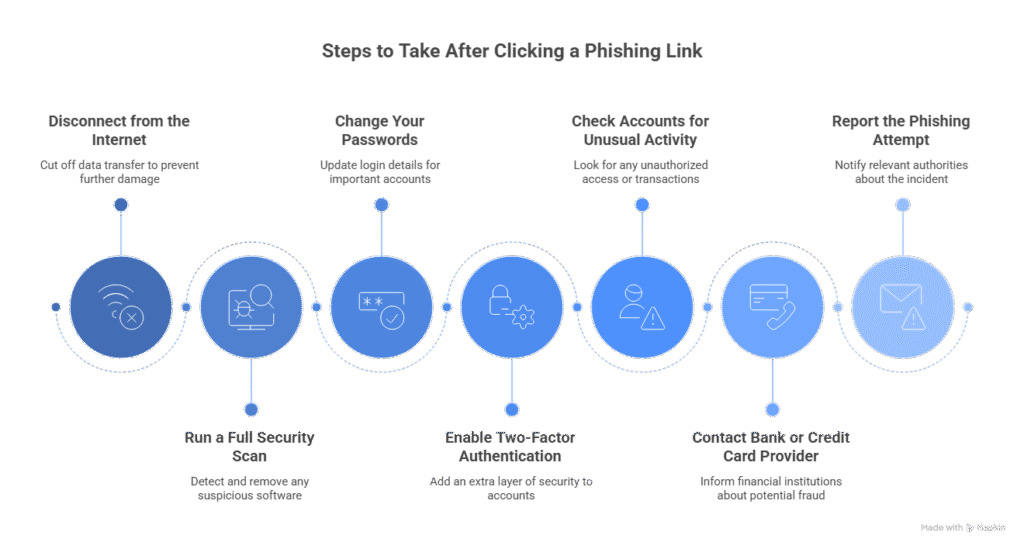
How Can You Protect Yourself From Phishing in The Future?
Clicking on a phishing link can happen to anyone, but there are simple steps you can take to protect yourself and avoid similar risks in the future. Here’s how:
1. Be cautious with unexpected messages
Many phishing emails and texts try to scare you into acting fast, with subject lines like “Your account will be suspended today” or “Unusual activity detected.” Take a moment before clicking anything. If it feels rushed or suspicious, that’s already a warning sign.
2. Check the sender’s details carefully
Scammers often pretend to be real companies, but their email addresses or phone numbers usually contain small errors, like extra letters, unusual domains, or strange characters. For example, support@paypaI.com (with a capital “i” instead of an “l”) is a common trick.
3. Hover over links before clicking
On a computer, move your mouse over the link to preview the actual web address. On a phone, press and hold the link to see where it leads. If the URL looks unfamiliar, misspelled, or unrelated to the sender, it’s safer not to open it.
4. Keep your software updated
Outdated systems and apps can have security holes that phishing malware exploits. Updating your browser, phone, and operating system ensures you’re running with the latest protections against known threats.
5. Use strong and unique passwords
If one password is stolen, reusing it across multiple accounts puts all of them at risk. Create unique passwords for each account and store them securely with a password manager so you don’t have to memorize them all.
6. Turn on two-factor authentication (2FA)
With 2FA, even if an attacker gets your password, they still need a second code sent to your phone or generated by an app. This extra step can stop many account takeover attempts.
7. Stay informed about phishing tactics
Scammers change their methods over time. Some fake delivery updates, others pretend to be banks or streaming services. Reading about the latest scams and warning friends or coworkers makes everyone less likely to get caught.
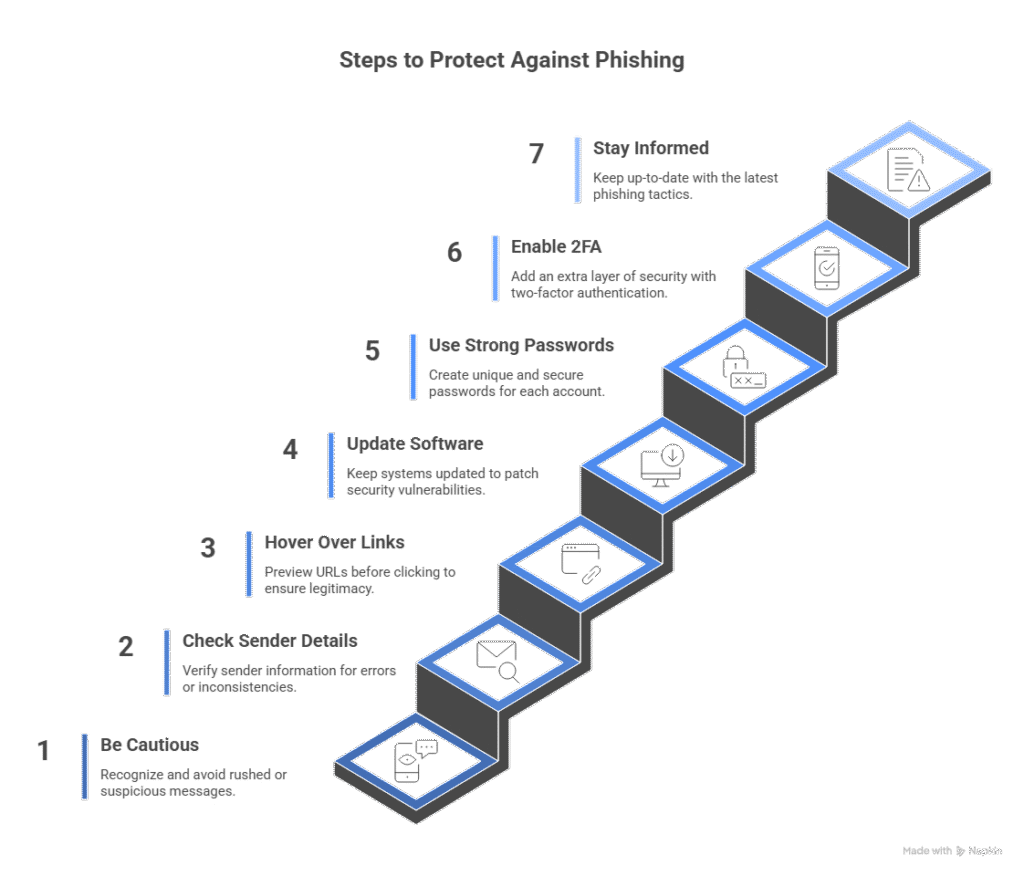
Stay Safe from Phishing and Fraud with Cryptoscam Defense Network
Phishing links are designed to trick, but they only succeed when we don’t know what to look for. Acting quickly after a suspicious click and creating safer habits online can help you stay in control of your accounts and personal information.
At Cryptoscam Defense Network, we care about helping you stay safe in the world of crypto. Our goal is to give you clear recommendations, practical tools, and trusted information so you can recognize online threats early and protect what matters most.
✅ Download our Fraud Report Toolkit to easily collect, organize, and report scam cases, with dropdowns for scam types, payment methods, platforms, and direct links to agencies like the FTC, FBI IC3, CFPB, BBB, and more.
We Want to Hear From You!
Fraud recovery is hard, but you don’t have to do it alone. Our community is here to help you share, learn, and protect yourself from future fraud.
Why Join Us?
- Community support: Share your experiences with people who understand.
- Useful resources: Learn from our tools and guides to prevent fraud.
- Safe space: A welcoming place to share your story and receive support.
Find the help you need. Join our Facebook group or contact us directly.
Be a part of the change. Your story matters.
Frequently Asked Questions (FAQs) About What Happens If You Click on a Phishing Link
What To do If I Opened a Phishing PDF?
If you opened a PDF from a phishing email, don’t panic. First, disconnect your device from the internet to stop any possible malicious activity. Next, run a full antivirus or anti-malware scan to check if any harmful software has been installed.
If you shared any information after opening the file, change those passwords immediately and notify your bank or service provider if financial details were compromised. Finally, delete the file and report the phishing attempt to your email provider or security team.
Is It Safe If I Clicked But didn’t Enter Any Information?
If you clicked a phishing link but didn’t type in your details, the risk is lower, but not zero. Some phishing links install malware silently. Running a scan and keeping an eye on your accounts is the safest approach.
Should I reset my phone if I clicked on a phishing link?
In most cases, a reset is not the first step. Start by running a security scan and checking for suspicious apps or activity. If the device continues to behave strangely, or if malware is confirmed, a factory reset may be the safest option. Always back up important data before doing this.
Photos via Freepik.

